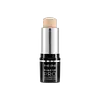Oriflame The One Make-Up Pro All Cover Stick Foundation Versus Oriflame Giordani Gold Long Wear Mineral Foundation SPF 20
What's inside
What's inside
 Key Ingredients
Key Ingredients

 Benefits
Benefits

 Concerns
Concerns

 Ingredients Side-by-side
Ingredients Side-by-side

Isononyl Isononanoate
EmollientTitanium Dioxide
Cosmetic ColorantSynthetic Wax
AbrasiveOctyldodecanol
EmollientPhenyl Trimethicone
Skin ConditioningCaprylic/Capric Triglyceride
MaskingPolymethyl Methacrylate
Hydrogenated Coconut Oil
EmollientTribehenin
EmollientVp/Hexadecene Copolymer
Caprylyl Glycol
EmollientBis-Diglyceryl Polyacyladipate-2
EmollientBisabolol
MaskingPolyhydroxystearic Acid
EmulsifyingTriethoxycaprylylsilane
CI 77492
Cosmetic ColorantCI 77491
Cosmetic ColorantCI 77499
Cosmetic ColorantIsononyl Isononanoate, Titanium Dioxide, Synthetic Wax, Octyldodecanol, Phenyl Trimethicone, Caprylic/Capric Triglyceride, Polymethyl Methacrylate, Hydrogenated Coconut Oil, Tribehenin, Vp/Hexadecene Copolymer, Caprylyl Glycol, Bis-Diglyceryl Polyacyladipate-2, Bisabolol, Polyhydroxystearic Acid, Triethoxycaprylylsilane, CI 77492, CI 77491, CI 77499
Water
Skin ConditioningPropanediol
SolventIsononyl Isononanoate
EmollientCaprylyl Methicone
Skin ConditioningDiisopropyl Adipate
EmollientDimethicone
EmollientTrimethylsiloxysilicate
EmollientPolyglyceryl-4 Isostearate
EmulsifyingCetyl PEG/PPG-10/1 Dimethicone
EmulsifyingHexyl Laurate
EmollientDiethylamino Hydroxybenzoyl Hexyl Benzoate
UV FilterSodium Chloride
MaskingDimethicone/Vinyl Dimethicone Crosspolymer
Skin Conditioning1,2-Hexanediol
Skin ConditioningDisteardimonium Hectorite
StabilisingSilica
AbrasiveStearic Acid
CleansingAluminum Hydroxide
EmollientHydroxyacetophenone
AntioxidantSodium Gluconate
Skin ConditioningTocopheryl Acetate
AntioxidantParfum
MaskingAlumina
AbrasiveTriethoxycaprylylsilane
Saccharomyces/Copper Ferment
Skin ConditioningSaccharomyces/Iron Ferment
Skin ConditioningSaccharomyces/Magnesium Ferment
Saccharomyces/Silicon Ferment
Skin ConditioningSaccharomyces/Zinc Ferment
Skin ConditioningLeuconostoc/Radish Root Ferment Filtrate
AntimicrobialLinoleic Acid
CleansingOleic Acid
EmollientPalmitic Acid
EmollientPentaerythrityl Tetra-Di-T-Butyl Hydroxyhydrocinnamate
AntioxidantLinolenic Acid
CleansingTocopherol
AntioxidantCI 77891
Cosmetic ColorantCI 77492
Cosmetic ColorantCI 77491
Cosmetic ColorantCI 77499
Cosmetic ColorantWater, Propanediol, Isononyl Isononanoate, Caprylyl Methicone, Diisopropyl Adipate, Dimethicone, Trimethylsiloxysilicate, Polyglyceryl-4 Isostearate, Cetyl PEG/PPG-10/1 Dimethicone, Hexyl Laurate, Diethylamino Hydroxybenzoyl Hexyl Benzoate, Sodium Chloride, Dimethicone/Vinyl Dimethicone Crosspolymer, 1,2-Hexanediol, Disteardimonium Hectorite, Silica, Stearic Acid, Aluminum Hydroxide, Hydroxyacetophenone, Sodium Gluconate, Tocopheryl Acetate, Parfum, Alumina, Triethoxycaprylylsilane, Saccharomyces/Copper Ferment, Saccharomyces/Iron Ferment, Saccharomyces/Magnesium Ferment, Saccharomyces/Silicon Ferment, Saccharomyces/Zinc Ferment, Leuconostoc/Radish Root Ferment Filtrate, Linoleic Acid, Oleic Acid, Palmitic Acid, Pentaerythrityl Tetra-Di-T-Butyl Hydroxyhydrocinnamate, Linolenic Acid, Tocopherol, CI 77891, CI 77492, CI 77491, CI 77499
Ingredients Explained
These ingredients are found in both products.
Ingredients higher up in an ingredient list are typically present in a larger amount.
Ci 77491 is also hydrated iron III oxide. It's sole purpose is to give a red/pink hue to products.
Iron III oxides are classified as inorganic chemicals for coloring.
Synthetically created Ci 77491 is considered safer than those naturally found. This is because the synthetically created version may contain less impurities. Iron oxides are generally non-toxic and non-allergenic.
Learn more about CI 77491Ci 77492 is also hydrated iron III oxide. It's sole purpose is to give a yellow hue to products.
Iron III oxides are classified as inorganic chemicals for coloring.
Synthetically created Ci 77492 is considered safer than those naturally found. This is because the synthetically created version may contain less impurities. Iron oxides are generally non-toxic and non-allergenic.
Learn more about CI 77492Ci 77499 is also hydrated iron III oxide. It is created from mixing red and black iron oxides. This helps give shades of darkness to a product.
Iron III oxides are classified as inorganic chemicals for coloring.
Isononyl Isononanoate is a synthetic skin-conditioner and texture enhancer. It is created from nonanoic acid, a fatty acid found in cocoa and lavender oil.
As an emollient, Isononyl Isononanoate helps keep your skin soft and smooth. This is because emollients create a barrier on the skin to trap moisture in.
Isononyl Isononanoate helps give products a velvet feel and improves spreadability.
Learn more about Isononyl IsononanoateTriethoxycaprylylsilane is a silicone used to bind and stabilize ingredients.
As an emulsifier, it helps prevent ingredients from separating. This can help elongate the shelf life of products.
Triethoxycaprylylsilane is often used to coat mineral sunscreens ingredients to help give a better feel. It also helps reduce oxidative stress in sunscreens.
Learn more about Triethoxycaprylylsilane